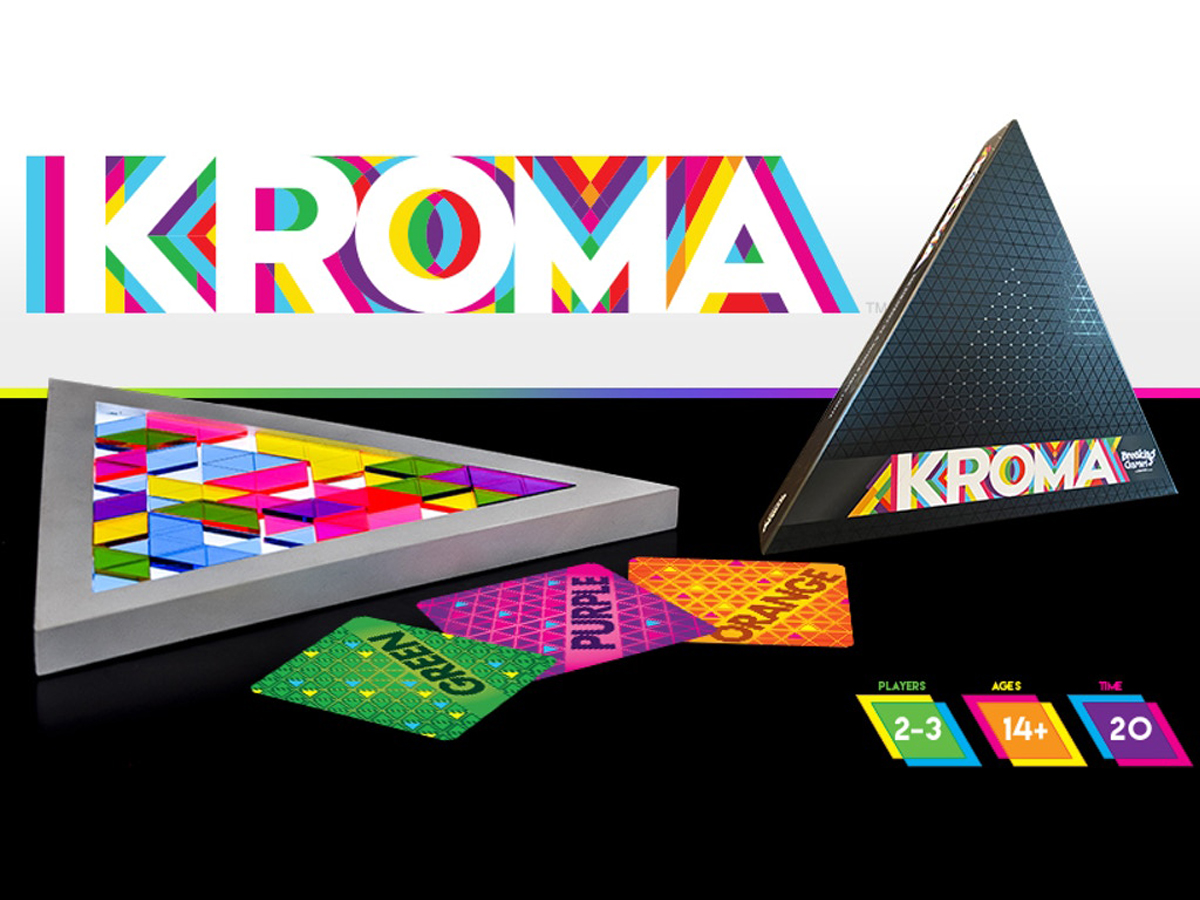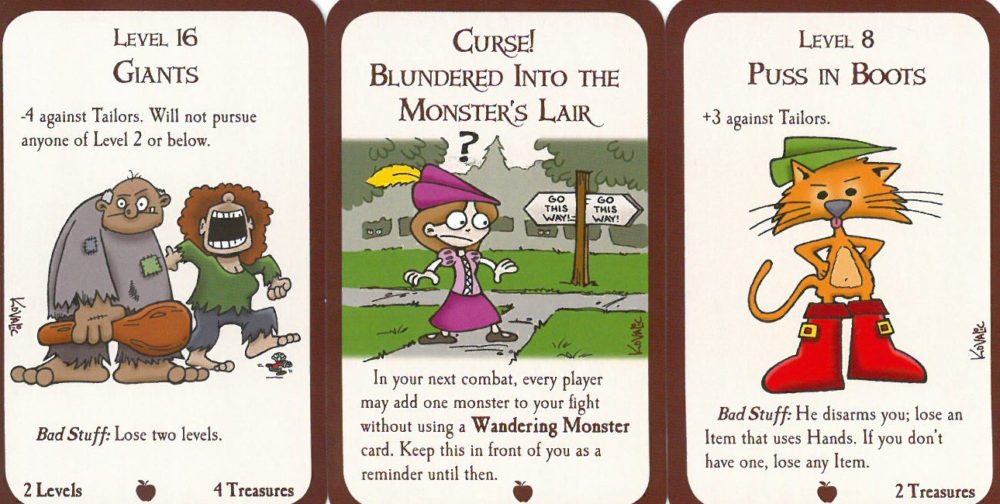Blend colors to form your target in this abstract strategy game.
What Is KROMA?
KROMA is a color-based tile-laying game for 2 or 3 players, ages 13 and up, and takes about 10–20 minutes to play. It’s currently seeking funding on Kickstarter. Although the listing says 13+, I think the game’s rules and concept are simple enough that you could play with much younger players, and even kids as young as 5 or 6 would probably enjoy making patterns and combining colors. The primary age restriction would be with the components themselves, since the board has LED lighting and the colored pieces are laser-cut acrylic with sharp corners.
KROMA was designed by Francesca Carletto-Leon, Kai Karhu, Carol Mertz, and Temitope Olujobi, and published by Breaking Games.
New to Kickstarter? Check out our crowdfunding primer.
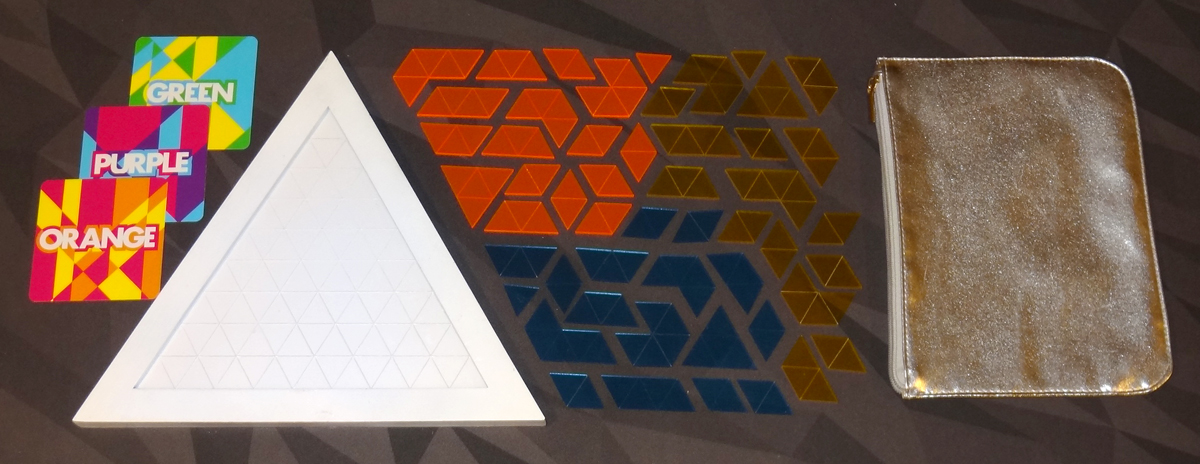
KROMA Components
Note: My review is based on a prototype copy, so it is subject to change and may not reflect final component quality.
Here’s what comes in the game:
- Triangle board
- 51 Pieces (17 each in cyan, magenta, and yellow)
- 3 Target Color cards
- Bag
The triangle board is actually a light board—it’s a frame, topped by a piece of white acrylic with triangular grid lines on it, and bright LED lighting inside. (The prototype has a micro USB charging port on one side, as well as a power button to turn it on and off.) The light shines through the transparent colored pieces so that layering them will combine their colors; my only complaint is that the light is bright enough that it can be irritating or painful to look at, depending on the ambient light. It would be nice to have either a lower setting (the bright setting might be good for outdoors or brighter settings), or else some sort of filter that you could overlay to dim it, though it would be important to still allow the light to shine through enough to combine the colors.
The colored pieces are various shapes made up of triangles—from 1 to 5 triangles—in three colors: cyan, magenta, and yellow. When layered on the board, the colors can be combined to make green, orange, and purple. While the board has grid lines to help you line things up, and the frame serves as an outer lip that can hold things in place, things can slide around within the frame so you do have to be careful not to bump things.
The target color cards are just large cards with a bit of a pattern in the background that say “Green,” “Orange,” and “Purple.” The prototype came with a zippered pouch for the pieces, though I’m not sure if that’s the type of bag planned for the finished copy.
And—although this may not be a huge consideration for many players—the lighted board makes KROMA really tricky to photograph. Either the board is too bright to see and the colors are washed out, or the surrounding table is too dark. I’ve retouched my photos just to make things a little easier to see.
How to Play KROMA
You can download a draft of the rulebook here.
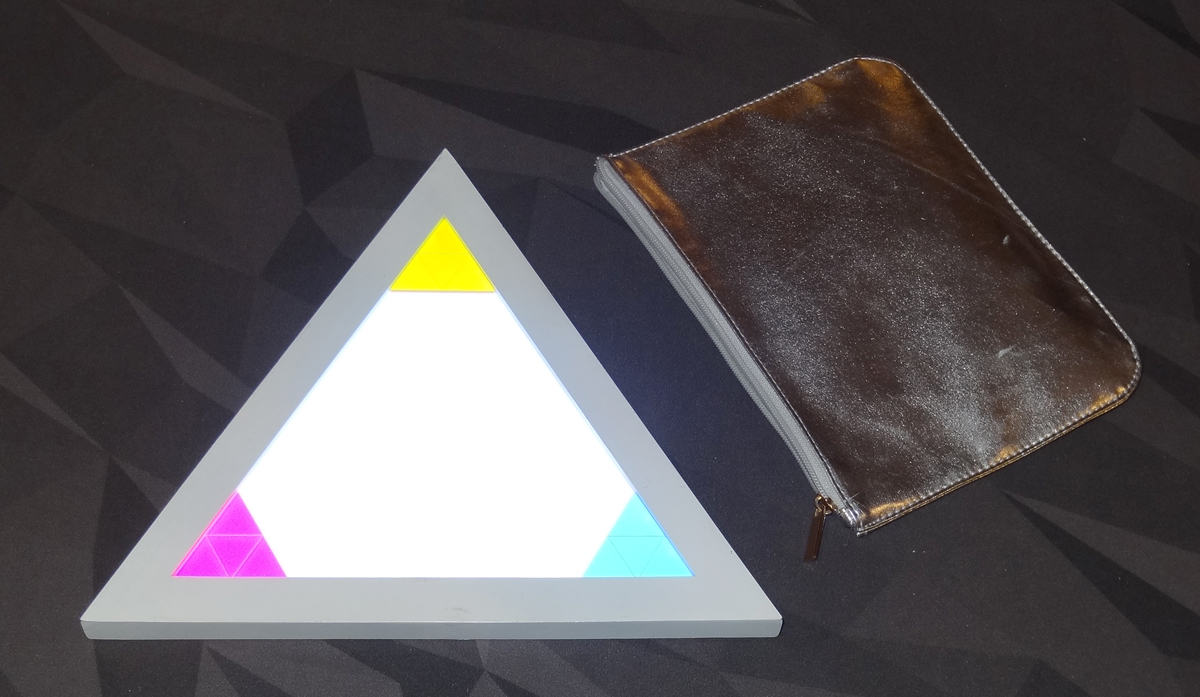
The Goal
In a 3-player game, the goal is to have the most area of your target color (but it does not have to be contiguous). In a 2-player game, the goal is to create the largest contiguous area of your target color.
Setup
Shuffle the target color cards and give one to each player—these are revealed. Set the board in the center and turn on the light. In a 3-player game, put the large triangle pieces in the three corners of the board. Put the remaining pieces in the bag and mix them up.
Gameplay
Gameplay is simple: on your turn, pull a piece from the bag and place it on the board. You can feel the shapes of the pieces in the bag, but aren’t allowed to peek at the color.

When you place pieces on the board, you may build up to two layers; the top layer must be completely supported by the bottom—no overhangs or holes. Otherwise, pieces may be played anywhere there is available space.
You must place the piece if there is room for it; if not, you discard it and pass your turn.
Game End
The game ends when all of the pieces have been drawn and placed on the board (or discarded).
In a 3-player game, the player with the most triangles’ worth of their target color wins, with ties going to the player with the largest contiguous region of their color.
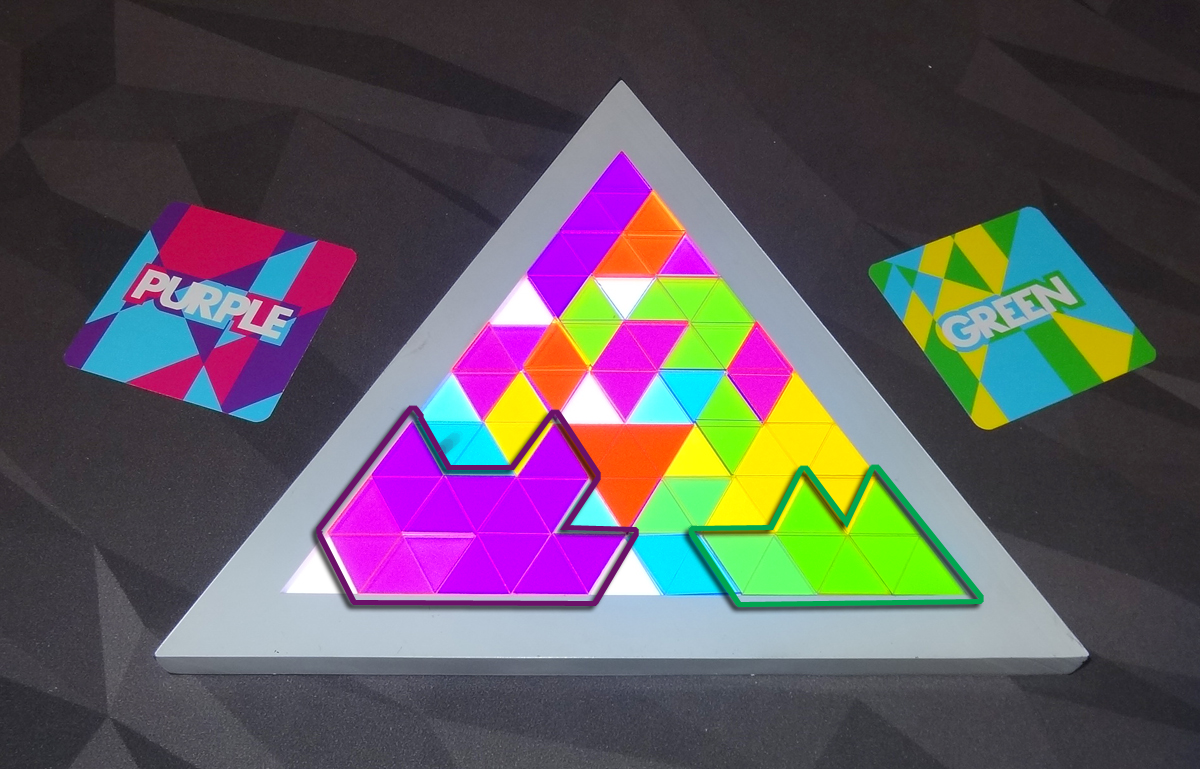
In a 2-player game, the player with the largest contiguous region of their target color wins, with ties going to the player with more total area of their target color.
Why You Should Play KROMA
KROMA is extremely easy to learn: the rules are intuitive and the color-blending is something that even younger kids will get (though they may wonder at first why it’s CMY instead of RGB). It has the feel of games like Blokus, a classic abstract game—there aren’t illustrations or anything to suggest a theme other than filling space with pieces. You can teach the game in a minute and start playing.
There are some interesting things going on in terms of strategy, though. You share a primary color with each rival, and there’s one primary color that is meaningless to you (but is needed by both rivals). When you draw the color you can’t use, you want to try to find a place to dump it that doesn’t help your opponents—if possible, you can even stack it on top of the same color, because that renders it useless. But the colors you can use: if you place it on the bottom layer, at least one of your opponents may be able to fill in on top of it and get their target color instead.
For the larger pieces (and the single-triangle pieces), there’s only one of each color. Digging around for those is an interesting gamble. For instance, if you draw the first Pac-Man shaped piece, does that help you or not? If it’s your useless color, then you’ve guaranteed that one of your rivals will be able to find another Pac-Man piece and complete their color. If it’s one of the colors you need, your opponent has a 50/50 chance of drawing the other one you need, and dumping it, or drawing the one they need to complete their color. It seemed like a bad idea to me to draw the larger pieces at first, until there’s enough of a bottom layer that you could put a larger piece onto it, if you got the right color.

Another consideration is whether to give an opponent any points when placing your piece. If you have a piece that could give you a few triangles of your color, but also overlaps another color and helps a rival, when is it worth it to place it anyway, compared to building out more of a bottom layer?
The 2-player and 3-player games have some subtle differences, since the 2-player game requires your target to be contiguous. Then, there’s a lot of playing colors to block the opponent. Each of you needs one color that the other player can’t use, so you could use that particular color to cut off connections. In a 3-player game, the knowledge that every color can be used by one of your opponents means that you have to think about what you’re opening up every time you place a piece on the bottom layer.
There’s some luck involved, of course, since you’re drawing pieces out of the bag. I’ve seen games where one player just had bad luck and kept pulling the one color that didn’t help them, so they just kept setting up other players to make combinations, and that can be frustrating. You do have a little bit of control in feeling for particular shapes, which can be helpful if you can remember which colors of the unique shapes have been played already.
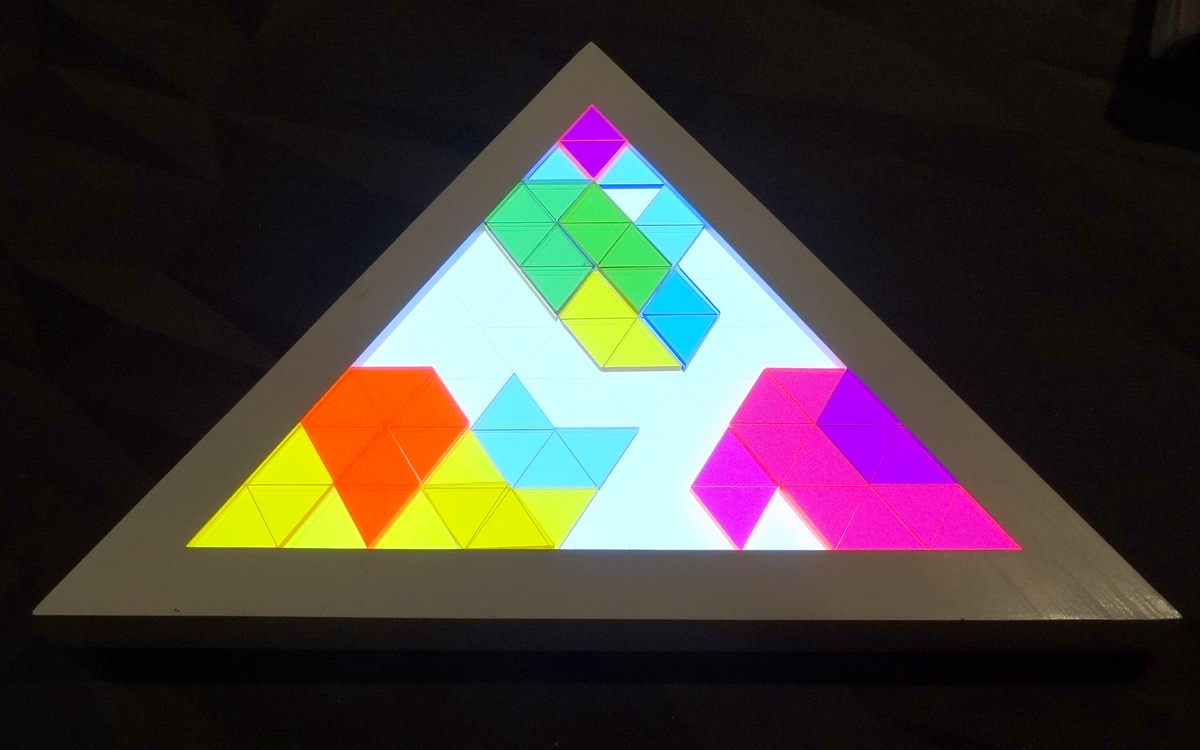
The one other downside—mentioned already in the components section—is simply that it can be a bit hard on the eyes, depending on the lighting. I played mostly indoors in a well-lit room (in the evenings, so there wasn’t any sunlight), and the board felt a bit like staring at a really bright phone screen. It helps to look away from the game periodically to give your eyes a break. I hope there’s some way in the finished product to dim the light a little, but because of the way the color combinations work, it doesn’t really work when the light’s off. It is fun to look at otherwise, as the pieces fill up the board and you get a colorful mosaic.
If you enjoy abstract strategy, and playing with light and colors, take a look at KROMA!
For more information or to make a pledge, visit the KROMA Kickstarter page!
Click here to see all our tabletop game reviews.
![]() To subscribe to GeekDad’s tabletop gaming coverage, please copy this link and add it to your RSS reader.
To subscribe to GeekDad’s tabletop gaming coverage, please copy this link and add it to your RSS reader.
Disclosure: GeekDad was loaned a prototype of this game for review purposes.
